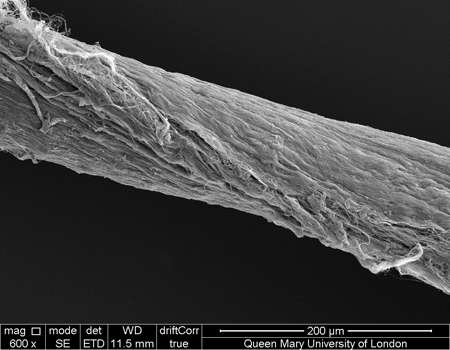http://www.qmul.ac.uk/media/images/119290.jpg
Tendons, such as the Achilles, connect muscle to bone, and are loaded repeatedly during movement. When exposed to particularly high loads, this can cause injury in some individuals. The risk of injury increases with age, but scientists have never fully understood why.
Tendon injury is common in horses as well as humans, and the team, working together with scientists from the University of Liverpool, University College London and the University of East Anglia, used tendons from horses already deceased to understand injury risk, and demonstrate the mechanism in action.
The research team found that fascicles – the subunit that makes up tendons – are coiled like a spring, or helix. They have shown that the helix structure enables tendons to stretch and recover, with results suggesting that damage to the helix stops the tendon working properly.
"The helical shape of the fascicles seems to be critical in maintaining tendon elasticity," explains co-author Dr Hazel Screen, a Reader in medical engineering at Queen Mary's School of Engineering and Materials Science.
"Repetitive loading causes the fascicles to unwind and be less effective, triggering them to become damaged or leading to injury."
The team also showed how ageing affects the helix.
Scanning electron microscopy image showing helix structure in a tendon fascicle
Co-author Dr Chavaunne Thorpe said: "The findings suggest that the helix structure is altered with age resulting in a decreased ability to withstand further loading and so making aged tendons more prone to injury."
More information: Chavaunne T. Thorpe, Graham P. Riley, Helen L. Birch, Peter D. Clegg, and Hazel R. C. Screen. "Fascicles from energy-storing tendons show an age-specific response to cyclic fatigue loading." J. R. Soc. Interface March 6, 2014 11 92 20131058; DOI: 10.1098/rsif.2013.1058 1742-5662
Journal information: Journal of the Royal Society Interface
Provided by Queen Mary, University of London






















